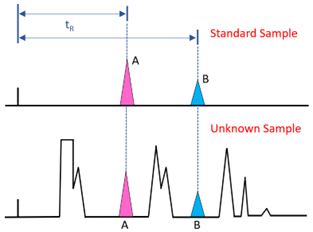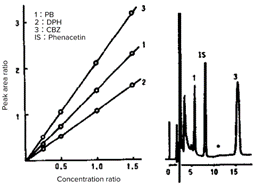Qualitative Analysis
In most cases, identification of a target component in an unknown sample is performed by comparing the retention time of the target component to that of a standard sample. If a complex chromatogram with many peaks is obtained or if the retention time of the target component differs from the standard sample, the target component can be identified by adding the standard sample to the unknown sample (Fig. 1).

Quantitative Analysis
There are two methods for quantification: external and internal standard methods, both of which are performed using a calibration curve. The external standard method creates a calibration curve by plotting standard concentration versus peak area. Unknown samples are quantified by extrapolating their concentration from their peak area based on the standard calibration curve. The internal standard method creates a calibration curve by adding a fixed amount of internal standard to different concentrations of standard and plotting standard concentration versus the ratio of the peak areas (peak area of standard divided by peak area of internal standard). The same fixed amount of internal standard is also added to the unknown samples which are quantified by extrapolating their concentration from the ratio of peak areas (peak area of unknown sample divided by peak area of internal standard).
When using the internal standard method, the internal standard is required to be a component not included in the unknown samples, to produce peaks that are completely separable from those for any contamination components, to elute at a retention time close to the quantitative target component, to be chemically and physically stable, and to be highly pure. The advantage of the internal standard method is that it improves the precision of quantitative analysis by reducing error in the injection volume or those caused by evaporation of the solvent.

Procedure for Establishing Analysis Conditions
Step 1. Clarify the purpose of the analysis and investigate the components to be analyzed:
Molecular weight, molecular structure, and functional groups of components
Properties (solubility, stability, UV/Visible or fluorescence spectrum, etc.) of components
Sample state (content, concentration, impurities)
Preliminary examination of analysis conditions and pretreatment based on data collections, literature, etc.
Step 2. Consider analysis conditions (column type, mobile phase composition, temperature, separation method, and detection method):
Confirmation of component peaks in standard samples using relatively high concentrations and examination of separation conditions
Measurement at the required concentration, determination of detection method Examination of pretreatment of unknown samples
Confirmation of separation of target components and contaminants in unknown samples
Step 3. Determination of analysis conditions for routine measurements:
Determination of calibration curve linearity and calibration curve type
Quantitative reproducibility including pretreatment
Confirmation of components that are strongly retained in the column and components that are not detected by the detector
Correlation with other quantitative methods
Step 4. Routine quantitative analysis:
Clarification of measurement procedure and documentation
System and column maintenance
Column lifetime
Running cost
